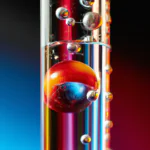Fire is one of the most fascinating things in the world. It’s also one of the most dangerous. But what is fire? What temperature is it? How is it measured?
Table of Contents
What is fire temperature
Orange flames range from around 1100°C to 1200°C. White flames are hotter, measuring 1300°C to about 1500°C. The brighter the white, the higher the temperature. For blue flames, or flames with a blue base, you can expect the temperature to rise dramatically, hitting roughly 2500°C to 3000°C.
The colors of a flame are due to different electromagnetic radiations emitted by variously heated atoms in the flame. The black-body radiation curves of various colors overlap to give a typical flaming color that depends on both temperature and whether the flame is oxygen-rich or oxygen-poor.
Examples:
- Convection:
Convection occurs when heat is transferred by moving hot fluids or gases. In flames, this is most often caused by rising hot gases and vapors. The heat energy is then transferred to nearby objects through conduction. Convection is the primary means of heat transfer in most fires.
- Radiation:
Radiation occurs when heat energy is transferred through electromagnetic waves. In a fire, this happens when hot gases radiate their heat energy to cooler objects. Radiation is the primary means of heat transfer in embers, coals, and charcoal.
What temperature is fire from a lighter?
Disposable butane lighters can potentially produce flames as hot as 4,074 degrees Fahrenheit, while their naphthalene counterparts can reach 4,591 degrees. However, factors like air movement and ambient temperature usually limit this.
The heat from a lighter’s flame depends on the fuel type. Butane and naphthalene are common fuels for lighters. Fire coming from butane is about 2,700 degrees Fahrenheit, while naphthalene can burn at temperatures above 3,000 degrees Fahrenheit.
The chemical reaction that produces the flame also plays a role in how hot it can get. For example, the combustion of hydrogen gas produces a flame that can reach up to 4,482 degrees Fahrenheit.
But in most cases, the maximum temperature that a lighter’s flame can reach is limited by the amount of oxygen available. If there’s not enough oxygen to support the combustion reaction, the flame will be extinguished.
Oxygen also affects the color of the flame. A blue flame indicates that the fuel is burning cleanly and there’s plenty of oxygen available. A yellow or orange flame means that the fuel isn’t burning as efficiently and there may not be enough oxygen for complete combustion.
- Disposable butane lighters could potentially produce flames as hot as 4,074 degrees Fahrenheit, while their naphthalene counterparts could reach 4,591 degrees.
- The heat of the flame from a lighter depends on the fuel type. Butane and naphthalene are common fuels for lighters.
- The chemical reaction that produces the flame also plays a role in how hot it can get.
- But in most cases, the maximum temperature that a lighter’s flame can reach is limited by the amount of oxygen available.
- Oxygen also affects the color of the flame.
How is fire temperature measured?
Pyrometers, namely pellets, paints, or crayons manufactured to melt or change colors at specific temperatures, are commonly used to estimate fire temperatures in ecological studies (Fonteyn et al., 2011).
While fire managers have relied on various temperature proxies for many years, few studies have evaluated the accuracy of these methods (Millspaugh et al., 2013).
One method for measuring fire temperature is through the use of pyrometers, which are devices that measure the amount of heat emitted from a fire (Millspaugh et al., 2013).
Pyrometers come in many different forms, including pellets, paints, and crayons. Each type of pyrometer is designed to melt or change color at a specific temperature, allowing for an estimation of fire temperature (Fonteyn et al., 2011).
- Pellet pyrometers are small spheres that are placed in the fire. The pellet pyrometer will melt at a certain temperature, and the time it takes for the pellet to melt can be used to estimate the temperature of the fire (Millspaugh et al., 2013).
- Paint pyrometers consist of a wick that is coated with a layer of paint. The paint will change color when it reaches a certain temperature, allowing for an estimation of fire temperature (Fonteyn et al., 2011).
- Crayon pyrometers, also known as melting-point crayons, work similarly to paint pyrometers. A crayon is placed in the fire and the time it takes for the crayon to melt can be used to estimate the temperature of the fire (Millspaugh et al., 2013).
Accuracy is always a concern when estimating fire temperatures, as even small errors can lead to large discrepancies in calculations (Millspaugh et al., 2013).
Studies have shown that pellet pyrometers tend to be more accurate than paint or crayon pyrometers (Fonteyn et al., 2011). This is likely due to the fact that pellet pyrometers melt at a range of temperatures, while paint and crayon pyrometers only change color at a single temperature. Pellet pyrometers are also less likely to be affected by wind, which can cause paint and crayon pyrometers to give inaccurate readings (Fonteyn et al., 2011).
How hot is a wood fire?
Most types of wood will start combusting at about 300 degrees Celsius. The gases burn and increase the temperature of the wood to about 600 degrees Celsius (1,112 degrees Fahrenheit).
When wood is heated, the cellulose and hemi-cellulose it contains break down and react with oxygen from the air to form CO2, water vapour and various volatile hydrocarbons. This process is known as pyrolysis.
The initial combustion of the volatile compounds in the gas phase near the surface of the wood is known as combustion. The main exothermic reaction during combustion is:
- C6H10O5(s) + 6O2(g) → 6CO2(g) + 5H2O(g)
What is the hottest fire?
Acetylene and pure oxygen burns blue, at over 3,400C – the hottest temperature readily achievable with fuel and flame.
This chemical reaction is used in welding and cutting torches because it produces such a high heat. The flame can reach up to 6,300F, and is hot enough to melt most metals.
The high temperature is due to the exothermic nature of the reaction. When acetylene and oxygen react, they create products that have a higher energy than the reactants.
The reaction is:
2 C₂H₂ + O₂ → 2 CO₂ + H₂O
The products of the reaction are carbon dioxide and water vapor. These gases are less stable than the reactants, so they release energy as they return to stability.
The hottest part of the flame is where the reactants are being consumed. The products are also hot, but they quickly cool down as they expand into the atmosphere.
The heat from this reaction can be used for many purposes, from welding metal to cooking food. It is even being used to power rockets!
What is a fire flame?
A flame (from Latin flamma) is the visible, gaseous part of a fire. It is caused by a highly exothermic chemical reaction taking place in a thin zone. When flames are hot enough to have ionized gaseous components of sufficient density they are then considered plasma.
The combustion of a hydrocarbon within oxygen results in the formation of carbon dioxide, water vapor, and heat. The heat produced by the burning substance causes the gas to expand, forming particles of carbon soot. These particles are then drawn up into the flame, where they react with oxygen to form carbon dioxide and water vapor. The light produced by the burning of these gases is what we see as the flame. The color of the flame depends on the temperature of the gas.
Extinguishing fire
If you have one handy and are not already drenched with sweat, you can use a fire extinguisher to extinguish the flames.Extinguishers come in all shapes and sizes, but the basic principle is the same: use it to expel water or compressed gas onto whatever is burning.
When using a fire extinguisher, remember:
- Aim low toward the base of the fire.
- Hold the extinguisher 3-5 feet away from you and aim it at the base of the fire.
- Squeeze the handle to release the gas or liquid.
- Move around so that you’re not blocking any sources of oxygen.
- Getting the fire under control is only half the battle–you’ll want to make sure the blaze is completely out before you call it quits.
- Soak the area with water, heavy snow, or dirt.
- Pour buckets or ladle of water onto any burning materials. If you have some dirt or snow (indoors or out), use that instead.
- Cover the area with a blanket or rug.
- If the gas is hot enough, it will be ionized, and the flame will be blue.
- If the gas is not hot enough, it will not be ionized, and the flame will be yellow.
How do you make a fire?
- The first thing you need is some form of fuel. This can be anything from wood to coal to natural gas. Once you have your fuel, you need to get it burning. This is done by using a match or lighter to ignite the fuel.
- To keep the fire going, you need to add more fuel to it. This can be done by placing more wood on the fire or by using a bellows to blow air into it. Once you have enough fuel, the fire will continue to burn on its own.
What are some safety tips for handling fires?
- Never leave a fire unattended.
- Make sure all flammable materials are kept away from the fire.
- Keep a fire extinguisher handy in case of an emergency.




